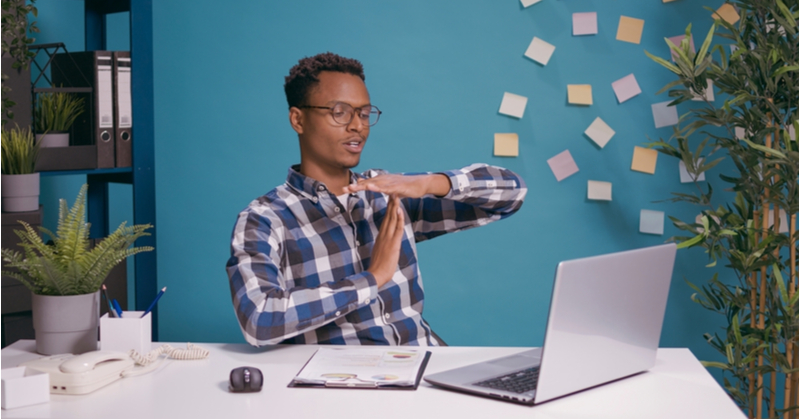You are in the thick of your busiest time of the year. Everyone is working at a fever pitch right now. Managing the stress that comes with this season isn’t easy, but it can be EASIER with a few little things you can do at your desk or workspace.
Don’t Tax Your Own Systems
Stress is natural, and low levels of it can actually be a good thing. It keeps us going toward our goals. It helps us remember things we have to do. It can actually excite us; this kind of stress is called “eustress” and is what we feel when we ride a roller coaster, obtain a promotion, go on a first date or work on something we are excited about.
As we all know, however, too much stress can be a killer. Don’t take that lightly. We chose that word intentionally. Stress can lower life expectancy, hasten disease onset, and do a number on your nervous system and stomach.
Mitigation is Key
Let’s take a look at a few easy ways to keep your stress in check as it happens.
Tune In. Turn It Up.
The power of music is undeniable. It can completely change the atmosphere around you. It can modify your mood and can even make you more productive. The beauty here is that with headphones or earbuds, you can glean the benefits without bothering those around you ANYTIME you want.
Researchers at Stanford University have found that “listening to music seems to be able to change brain functioning to the same extent as medication.”
Read that again.
Literal vibrations registering on your eardrum and being carried to your brain can have effects on you not unlike some medications.
That’s potent.
Upbeat music will make you feel more optimistic, while slower music can calm you down. Faster music can actually help you focus more.
Important here, though, is to pick something you like. If you force yourself to listen to music you don’t care for, you probably won’t get the effect you are looking for.
So if you are feeling a bit anxious or on edge, find something soothing, put the headphones in, turn it up to 11, and relax. Let those tunes adjust your brainwaves for a few minutes. Just exist for a while.
Take a Hike!
Not like a long one, though. You have work to do!
Go for a quick 10-15 minute walk then come back to your desk refreshed.
Walking has been shown to help improve your mental state, and to lower levels of anxiety, depression, and negative mood. It also boosts energy, in some cases, more than a cup of coffee according to at least one study.
The brain-body connection, and the clarity therein, can be improved and lead to higher levels of creative thinking - just by taking a walk. Trekking outdoors while trying to come up with new ideas has been studied to find an increase over simply sitting down while thinking.
So when things are really tense and you are feeling overextended, consider taking a step back and putting one foot in front of the other. Sometimes, walking it out is all you need.
Stretch It Out
If you have co-workers near you, this is a great way to make them think you’re crazier than they already do. Who cares…we’re all a little crazy, right!? Feel free to use them as standalone exercises, or incorporate them into some of the aforementioned things to supercharge your stress-lowering techniques. You really can’t go wrong here.
1. The forward fold
This one can be done sitting down or standing up. You feel it differently in both positions, so try each of them.
First, the standing version has you upright with your feet apart. Slightly bend your knees and allow your body to kinda-sorta collapse at the waist down. Don’t fall to the floor. That’s called a nap, and while those are AWESOME, that’s not what we’re going for here.
Bent at the waist and dangling toward the floor, sway side to side slowly feeling the stretch in your arms, shoulders, and lower back. If you want to take this to the next level, fold your arms behind your neck and pull on your elbow. Do this on both sides. You’ll feel an extra-awesome stretch down your arm into your side.
When you’re ready, slowly roll back up to standing normally.
The sitting version is basically the same, but you’re, you know…sitting. You won’t get as much of a shoulder and arm stretch, but your lower back will feel this one a bit more.
2. Chest stretch
Stand up for this one; it’s really simple, but it can’t be done while seated.
Reach your hands behind you and clasp them at the small of your back. Pull your shoulder blades together and lift your hands as high as you can.
Once you’ve reached maximum height, try to hold your arms there for five breaths. Feel free to modify this by raising and lowering your arms while you breathe in and out slowly.
To take this one to the next level, try bending at your waist as you raise your arms. This will allow gravity to do some work and add a few extra muscle groups into the stretch.
3. Upper trap stretch
This last stretch can be done sitting or standing. Get comfortable! This one is easy.
Tilt your head to one shoulder as if you’re trying to get your ear to rest there. Go as far as you’re comfortable with there. Hold this stretch for five breaths, then do the same thing on the other side.
For a next-level version (and only if you’re comfortable with it) is during the tilt, gently pull your head toward that shoulder with your hand. If you weren’t feeling it in the first version, this one is sure to engage the muscles in your neck, shoulder, and upper arm.
These simple stretches can be done while your favorite tunes are playing, while you’re out for a walk, or just simply getting a cup of coffee.
20-20 Vision
Staring at screens is pretty terrible for our eyes. They were never meant to look at pixels for hours on end without a break. Sure, screens are how the world works, and we aren’t severing any HDMI cords anytime soon, but give your eyes a breather every now and then.
There’s this rule, the 20-20-20 rule, that is aimed at helping relieve some of the inherent stress that comes from staring at a screen for long periods of time. It goes like this.
Every 20 minutes of looking at a screen, you should look away at something at least 20 feet away for at least 20 seconds. This gives your eyes a breath, so to say.
Another simple way to help your peepers out is to simply get up for 5-10 minutes each hour. Go for a short walk (sounds familiar). Go talk to a colleague. Go shadowbox in the restroom. Go pet a furry friend (if you’re lucky enough to have one around)...anything that isn’t screen-oriented works.
Two pro tips for everyone: if you have to stay staring at a screen for a long time, increasing your font size or magnification, per your specific device, can relieve the strain while looking at whatever screen you’re gazing at. The other is using a screen darkening extension (Dark Reader for Chrome is our favorite) to invert dark and light colors. This has made a huge difference for us.
Now Take a Breath
You’ve got this. If you think you need some help, Liscio can do that. Our tools eliminate the need to chase clients for documents, search in multiple places for information, or worry about security, This all saves you time and improves your sanity. And, if you really want to take a breath and relax, check out these breathing exercises over at our blog.
.png?width=150&height=63&name=TWRlogo-regmark_blueblack%20(1).png)
.png)










Do you have questions about this article? Email us and let us know > info@woodard.com
Comments: